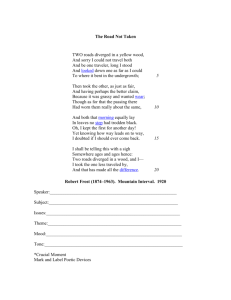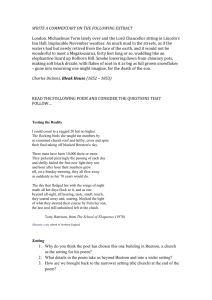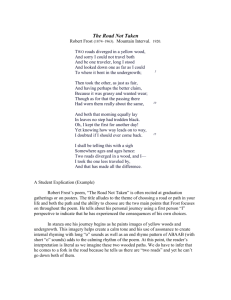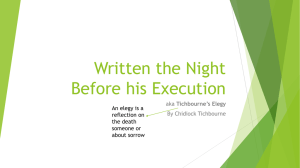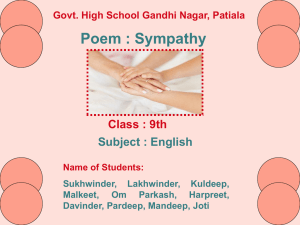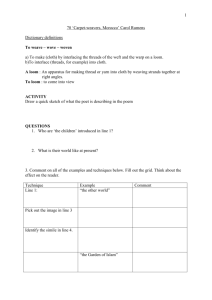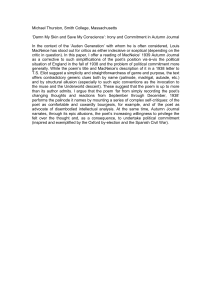Literal meaning of "The Road Not Taken" (1.) Two roads diverged in
advertisement
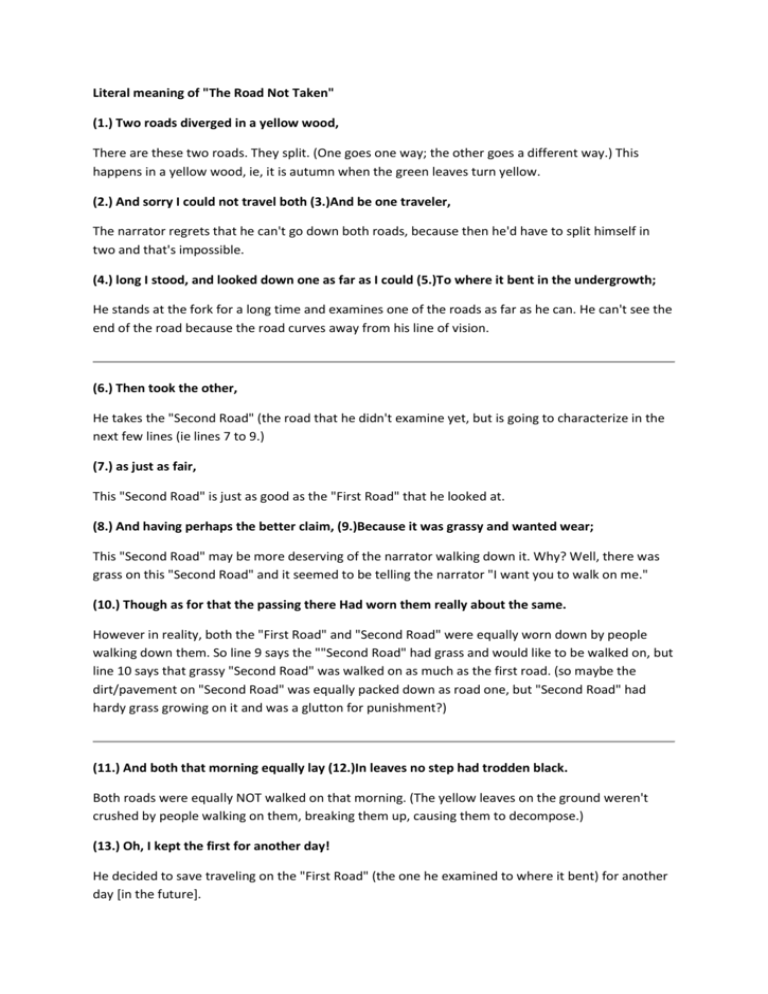
Literal meaning of "The Road Not Taken" (1.) Two roads diverged in a yellow wood, There are these two roads. They split. (One goes one way; the other goes a different way.) This happens in a yellow wood, ie, it is autumn when the green leaves turn yellow. (2.) And sorry I could not travel both (3.)And be one traveler, The narrator regrets that he can't go down both roads, because then he'd have to split himself in two and that's impossible. (4.) long I stood, and looked down one as far as I could (5.)To where it bent in the undergrowth; He stands at the fork for a long time and examines one of the roads as far as he can. He can't see the end of the road because the road curves away from his line of vision. (6.) Then took the other, He takes the "Second Road" (the road that he didn't examine yet, but is going to characterize in the next few lines (ie lines 7 to 9.) (7.) as just as fair, This "Second Road" is just as good as the "First Road" that he looked at. (8.) And having perhaps the better claim, (9.)Because it was grassy and wanted wear; This "Second Road" may be more deserving of the narrator walking down it. Why? Well, there was grass on this "Second Road" and it seemed to be telling the narrator "I want you to walk on me." (10.) Though as for that the passing there Had worn them really about the same. However in reality, both the "First Road" and "Second Road" were equally worn down by people walking down them. So line 9 says the ""Second Road" had grass and would like to be walked on, but line 10 says that grassy "Second Road" was walked on as much as the first road. (so maybe the dirt/pavement on "Second Road" was equally packed down as road one, but "Second Road" had hardy grass growing on it and was a glutton for punishment?) (11.) And both that morning equally lay (12.)In leaves no step had trodden black. Both roads were equally NOT walked on that morning. (The yellow leaves on the ground weren't crushed by people walking on them, breaking them up, causing them to decompose.) (13.) Oh, I kept the first for another day! He decided to save traveling on the "First Road" (the one he examined to where it bent) for another day [in the future]. (14.) Yet knowing how way leads on to way, (15.)I doubted if I should ever come back. But he suspects that he'll never follow through on that decision. Once he takes the second road, that road will lead to another fork and he’ll have to neglect another possible path choice. Hence, because of all the future road choices he knows he'll encounter, he thinks he's unlikely to ever come back and discover what this first road is like. (16.) I shall be telling this with a sigh (17.)Somewhere ages and ages hence: When he's much older, he will reminisce about this decision he is making. He'll do it with a sigh (of satisfaction? wistfulness? Regret? All of the above?) (18.) Two roads diverged in a wood, and I- (19.)I took the one less traveled by, He will say there were these two diverging roads and he took the less traveled one (20.) And that has made all the difference. Taking the less traveled road really changed his life. (For good? For bad? Neither good or bad, just different?) Relevant Background Robert Frost was born in San Francisco. He lived most of his life on a farm in the region of New England, on the eastern side of America. He went to university at Dartmouth College in 1892, and later Harvard, but never earned a formal degree Among his early jobs, he taught school and worked in a mill and as a newspaper reporter. His rich grandfather bought him a farm in New Hampshire. He wrote a lot of poems about country life and the beauty of landscape in the American state of New England. His poems could be about any place. He liked to use language as it is actually spoken. He is a poet of deep thoughts. The Road Not Taken shows Frost's ability to unite rural description with deep thinking. Summary This twenty-line poem contains four stanzas of five lines each. The poem is set in a wood in autumn. The poem cleverly combines memory with personal prophesy. It contains a mental picture from the poet’s past and future. On one level, the poem describes a woodland scene where a country road split into to two roads at a fork. It also describes a traveller’s regret at not being able to travel both roads. After making up his mind about what road to take, the traveller regretted not taking the other road. On a deeper level, the poem describes a dilemma or a no-win-situation. The poem explores feelings of curiosity and regret associated with making a decision: ‘and that has made all the difference’. In the first stanza, Frost describes the junction where two different roads split from the road he was walking on. He must have come to a ‘y’ junction or fork in the forest road. It must have been autumn because the leaves were ‘yellow’. The poet describes his long curious gaze down the road he didn’t take. The first road he looked at was a mystery, hidden by a bend. In the second stanza, Frost states that both roads seemed equally nice to a traveller like himself: ‘as just as fair’. The only difference was that one road had less signs of wear from travellers and walkers: ‘Because it was grassy and wanted wear’. ‘Wanted’ means lacked. The unworn look gave that road a ‘better claim’. Then, Frost changed his mind. He decided that both roads were in fact equally worn. In the third stanza, he provides another image of autumn by referring to the leaves that covered both roads. There was no sign of a footstep on the leaves of either road on that morning: ‘In leaves no step had trodden black’. Frost writes that he decided to stick to his decision about the second route. He consoled himself by saying that he would take the first road he looked at on another day. At the same time, he doubted whether he’d pass that way again. In the final stanza, he expects he will have regrets in the future about the road he didn’t take. ‘I shall be telling this with a sigh’. Frost expects that sometime in the future he will regret the decision he had to make in the wood. He then summarises the first and second stanza, by stating how he decided on his route: ‘and I-I took the one less travelled by’. Note the hesitation as shown by the repetition of ‘I’ Finally, Frost predicts that in the future he will claim that his choice of road that morning in the yellow wood ‘made all the difference’. He expects that his decision at the fork in the road will shape his life or destiny. Themes The theme of this poem is the direction you take in life: ‘Two roads diverged in a wood, and II took the one less travelled by, And that has made all the difference’. The theme of this poem is the poet’s inner conflict in dealing with difference: ‘sorry I could not travel both’. The poem shows how difficult it is to make a choice: ‘sorry I could not travel both and be one traveller’. The theme is that people would like to avoid decisions. The theme of this poem is that people don’t like to miss out on possibilities: ‘I shall be telling this with a sigh somewhere ages and ages hence’. The theme of this poem is indecision: ‘Though as for that the passing there Had worn them really about the same’. The poet shows that human beings are never satisfied: ‘sorry I could not travel both And be one traveller’. The poet shows his tendency to change his mind: ‘Oh, I kept the first for another day! Yet knowing how way leads on to way, I doubted if I should ever come back’. The poet values a fresh or individual approach: ‘having perhaps the better claim, Because it was grassy and wanted wear’. The poet urges that people should be individuals and not follow the majority: ‘I took the one less travelled by, And that has made all the difference’. The poet shows that humans cannot fulfil their intentions: ‘I doubted if I should ever come back’. Humans cannot control their destinies. Tones The tone at the start is factual: ‘Two roads diverged in a yellow wood’. Then the tone becomes regretful or sorry: ‘sorry I could not travel both’. Sometimes the tone is curious and fascinated: ‘long I stood and looked down one as far as I could’. Sometimes the tone is optimistic and calm: ‘Then took the other, as just as fair’. Sometimes the tone is confident and certain: ‘the passing there had worn them really about the same’. Sometimes the tone is gloomy: ‘In leaves no step had trodden black’. Sometimes the tone is offhand: ‘Oh, I kept the first for another day!’ Sometimes the tone is doubtful and dithering: ‘Yet knowing how way leads on to way, I doubted if I should ever come back’. Sometimes the tone is rueful or sorry: ‘I shall be telling this with a sigh somewhere ages and ages hence’. Sometimes the tone is awkward or faltering ‘ and I-I took’. Sometimes the tone is pleased and full of pride: ‘I took the one less travelled by, And that has made all the difference’. Imagery The central image is of the poet standing at a fork in a wood in autumn trying to make up his mind about which direction to take. There are images of the season, of nature and of travel. Two images show the season of autumn: ‘a yellow wood… ‘lay in leaves…’ There are five images of nature: ‘a yellow wood… the undergrowth… it was grassy … lay in leaves … in a wood …’ There are ten images of the poet or other people walking on a journey: ‘Two roads diverged … And sorry I could not travel both and be one traveller… long I stood and looked down one as far as I could… Then took the other, as just as fair… it was grassy and wanted wear… the passing there had worn them really about the same… both that morning equally lay in leaves no step had trodden black… knowing how way leads on to way… Two roads diverged in a wood, I took the one less travelled by…’ There are nine images of the poet making a simple decision and dealing with the consequences. The poem contains many examples of the language of choosing: ‘And sorry I could not travel both and be one traveller… long I stood and looked down one as far as I could… Then took the other, as just as fair, and having perhaps the better claim, because … Though as for that … Oh, I kept the first for another day! … Yet knowing how way leads on to way, I doubted if I should ever come back... I shall be telling this with a sigh Somewhere ages and ages hence… Two roads diverged in a wood, and II took the one less travelled by… And that has made all the difference.’ On a deeper level, the poet may be making a comparison between the fork in the road and decisionmaking. Each road represents a journey. The poet must choose only one. The bend in the road and the undergrowth stand for the hidden aspect of the future in one journey. The leaves that no one has walked on stand for the isolation of the poet. He is not following a lead. He has to step into the unknown. If you wish to, you can refer to this comparison as an analogy. An analogy is a parallel image. The comparison or analogy is an image for the poet’s inner conflict. The traveller and the fork in the road represent an inner conflict in the poet, a dilemma. A dilemma is when you face a difficult choice between two things. The analogy or comparison shows how it was a no-win-situation for the poet. Without this analogy or comparison, we would know a lot less about Frost’s feelings regarding his decision. If you read the poem on this level, you will see that making a moral choice is the subject of the poem.
